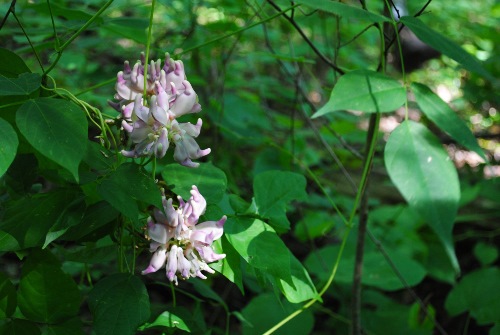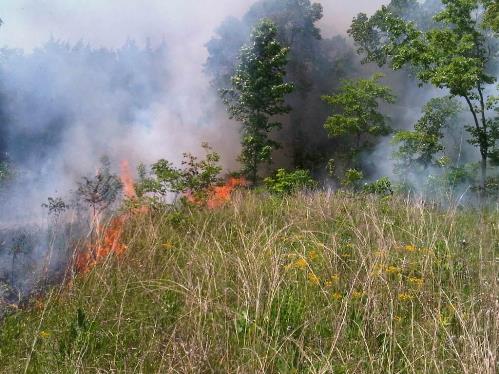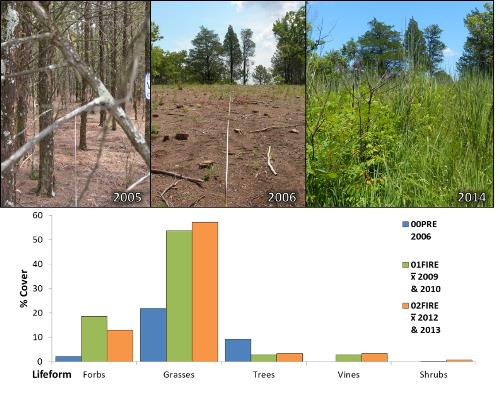Restoring Rare and Threatened Species on National Park Service Land

Image courtesy of NPS
Since the mid-2000s, fire and resource management staff at the Natchez Trace Parkway (NATR) has been working to identify and restore portions of the now rare Black Belt Prairie, through which a portion of the historic Natchez Trace traversed. Since 2006, these prairie restoration units have been the focus site of university research pertaining to native grassland insects and plants, as well as best management practices for southeastern prairie restoration. Simultaneously, these areas have been identified as a wildland fire urban-interface risk, due to the extreme density of the juniper, eastern redcedar (Juniperus virginiana), directly adjacent to homes, apartments, and schools within the Tupelo micropolitan area.
The primary objectives for fuel treatments within these units are to reduce the live fuel loading in the form of thick stands of redcedar adjacent to the urban area of Tupelo, MS and to reduce the accumulation of fine dead fuel within both forest and prairie vegetation. These objectives work hand-in-hand with ecological objectives of restoring this Black Belt Prairie, a critically imperiled (G1) prairie ecological association, and surrounding Black Belt Post Oak Woodland, an imperiled (G2) woodland association. The mechanical cutting of redcedar and subsequent prescribed fires greatly reduces the woody plant encroachment on these sites and restores historical nutrient cycles in the fragile calcareous chalky soils.

Image courtesy NPS
Currently, a complex of 12 burn units covering 886 acres in 3 counties are being treated with prescribed fire within the historic Black Belt Prairie region. This complex encompasses the greater part of the roughly 35 prairie remnants identified by Mississippi State University (MSU), NatureServe, and/or NPS employees. In 2005, a small area within NATR was identified by NatureServe as being an exceptional remnant prairie at risk of vanishing. Woody encroachment of redcedar had flourished so vigorously that the few remaining herbaceous prairie plants surviving would soon no longer grow on the site. NATR fire management staff established a prescribed burn unit at the site, along with extensive cutting and removal of the invasive juniper trees from the site. Fire management staff cut and removed the trees from the site in the summer of 2006. After this cutting, the area was allowed to regrow with herbaceous prairie plants until its first prescribed fire in the winter of 2008. The site was then retreated with a summer growing season prescribed fire (one of the very first NPS summer growing-season fires in this area) in 2011, then again with a spring burn in 2012, and a winter burn in 2014.
In addition to cutting and burning, NATR fire management staff work closely with resource management staff to carefully herbicide and mow small portions of the unit, controlling invading exotic species. Exotic species at this site, such as sericea lespedeza (Lespedeza cuneata), Johnsongrass (Sorghum halepense), wisteria (Wisteria spp.), and privet (Ligustrum spp.) are an unrelenting problem at these sites due to the close proximity to both urban and agricultural lands. The sericea lespedeza and Johnsongrass are currently found throughout the Blackbelt Restoration Unit; however, progress has been made in minimizing their spread.
Within this single 15-acre Black Belt restoration site, floristic surveys by NPS, MSU, and Columbus University staff have identified numerous plants now uncommon for the region, including the following unique/rare species: eastern purple coneflower (Echinacea purpurea, S3 [State Rare]), American columbo (Frasera caroliniensis, S3), yellow horse gentian (Triosteum angustifolium, S3), mullein foxglove (Dasistoma macrophylla, S3), Great Plains lady's tresses (Spiranthes magnicamporum, S3), prairie parsley (Polytaenia nuttallii, S2 [State Imperiled]), shadow-witch orchid (Ponthieva racemosa, S2), and shooting star (Dodecatheon meadia, S2).

Image courtesy NPS
In the summer of 2014, a USGS-NPS Vegetation Characterization Program survey crew working with the Alabama Natural Heritage Program discovered and confirmed the presence of the federally-protected Price’s potato bean (Apios priceana, Globally Vulnerable [G2] and State Critically Imperiled [S1]) within this prescribed burn and mechanical treatment unit. It has been suggested since the 1980s that this species requires open savanna-like habitat and would benefit from prescribed fire. However, few, if any, studies have confirmed this relationship. In a joint effort between Natchez Trace resource management staff and the fire effects module, the newly discovered population is now being closely monitored. Future plans are to continue redcedar thinning and prescribed burns while also working with cooperators in propagating and increasing the population size of Price’s potato bean within park lands.
The dedicated efforts of the fire management staff at NATR, of both today and over the last decade, should be commended and are directly responsible for providing suitable habitat for over a half-dozen rare and one federally-threatened plant species. The continuing work of fire management will ensure that rare plant communities of the southeast threatened with extinction will continue to be preserved for future generations to enjoy.
Contact: Jesse Burton, Mississippi River Zone Fire Ecologist
E-mail: e-mail us
Phone: (662)840-7572
Last updated: December 14, 2017
